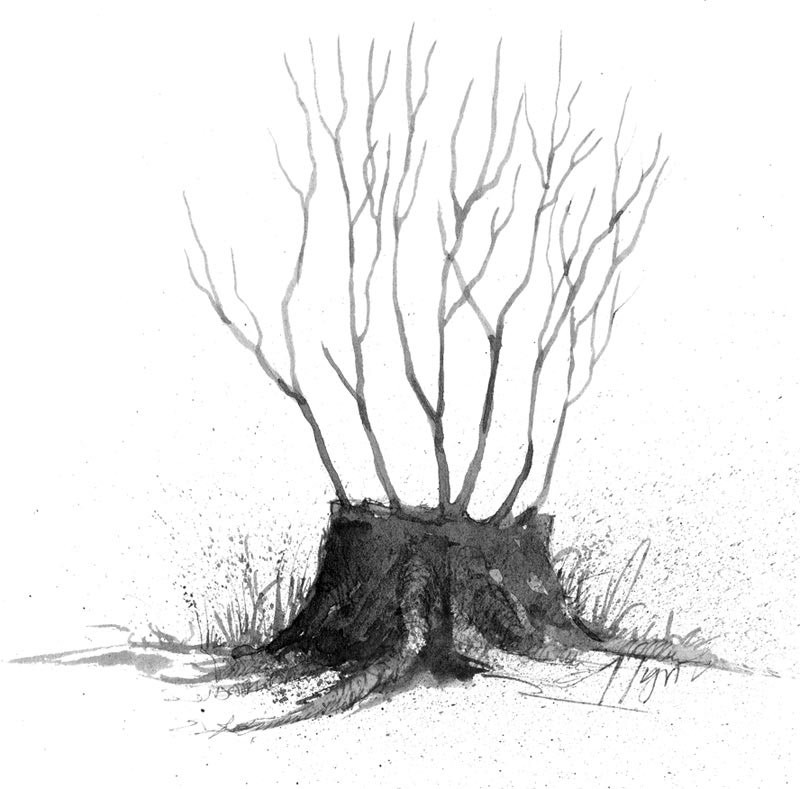
Twenty years ago when I bought my farm I made a snap decision to clear some woods near the house, all the way back to the stone wall. Out came the chainsaw and trees started crashing down.
I never did finish “neatening up” that section of the fence line. And it was only later that I realized that I had turned the only sizable northern red oak on the entire 40-acre woodlot into firewood. As a guy who prizes forest diversity, I was chagrined. No help for it. Except…a few years later I noticed some healthy sprouts from that oak stump. I left them alone. Now the three biggest are six to eight inches in diameter and some forty feet tall.
Stump sprouting is kind of like an insurance policy for many trees, even those that take other steps to ensure their species’ survival, such as producing prodigious quantities of seed. Most temperate hardwoods have this ability, though some, like oak and beech, are better at it than others. Most conifers do not, an exception being the redwood, which is a champion sprouter.
Sprouts are generated by different mechanisms, depending on the species, explained Kevin Smith, a plant physiologist with the U.S. Forest Service’s Northern Research Station. Sometimes sprouts are produced by dormant buds that remain immersed in the bark until the tree is stressed or injured and then are prompted to break dormancy. Other sprouts are produced from pads of juvenile callus formed from mature living wood cells.
“It’s quite a trick, but some species do it readily,” Smith noted.
The big advantage to stump sprouting is that the sprouts get access to the root system of the original tree and its accumulated energy reserves. (This is also true for trees that send sprouts up from their roots.) It’s like starting life with a huge trust fund. It’s no guarantee of success, but it gives you a head start.
There seems to be something of a “use it or lose it” aspect to this ability, however. In a 2001 study on tree sprouting published in The Botanical Review, the Arnold Arboretum’s Peter Del Tredici noted that hardwoods will sprout “vigorously” from stumps between about two to six inches in size and that most will continue to do so from stumps up to ten or twelve inches in size, but in lower percentages. Beyond ten to twelve inches, the “number of non-oak species that are capable of successful sprouting drops off precipitously,” Del Tredici wrote. The reasons for this size limit are poorly understood.
Humans have long exploited hardwoods’ sprouting tendency. In a practice called “coppicing,” young trees are allowed to regrow from stumps and harvested every few years. Historically – especially in Europe where forests can be scarce – coppices provided wood for a wide variety of uses, from firewood to fencing. Some stumps, called “stools,” have been harvested for centuries. Coppicing is still practiced, and is having something of a resurgence among permaculture devotees, but not to the extent that it once was.
Even if a tree produces copious numbers of sprouts, it’s no guarantee that they’ll all live. Some trees apparently “self thin” their sprout production. And in many cases sprouts die because they are infected by rot from the stump itself.
While many foresters profess not to like sprout clumps, Smith notes that at least one study shows that in New England, a lot of merchantable hardwood is produced by them. Beyond that, studies show that stump sprouting, in allowing rapid regrowth of trees, preserves the forest microclimate, inhibits erosion, and conserves nutrients.
“Part of the strength of our forests,” said Smith, is that most hardwoods have both the ability to sprout, perpetuating the original tree, and to produce seeds, which allows for a stirring of the gene pool. The combination, he said, “contributes to resiliency.”


Discussion *